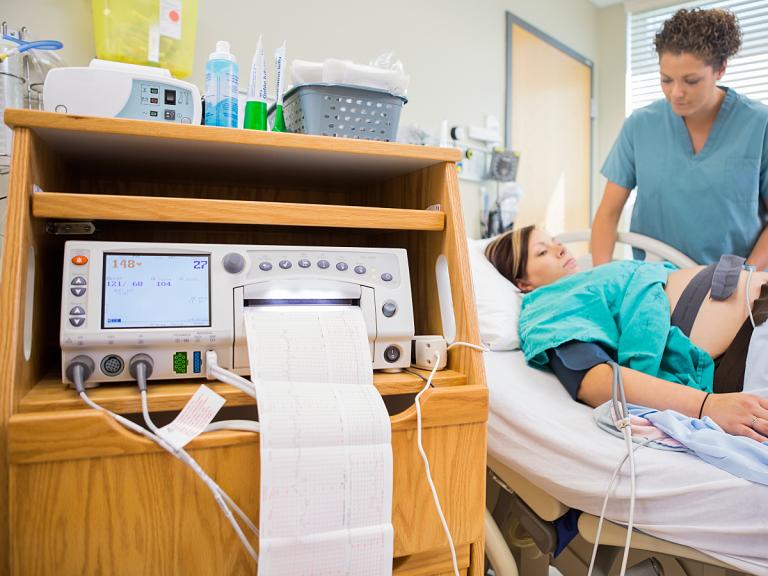
Meanwhile, clinicians have their own decisions to make, including which type of fetal monitoring to rely on throughout the birthing process.
In modern obstetric practice, clinicians use either intermittent or continuous fetal monitoring to detect changes in the fetal heart rate that might indicate a lack of oxygen to the fetus. Both of these electronic monitoring options can provide safe and effective insight into fetal well-being during the labor and delivery process. Additionally, patients and clinicians have more choices than ever to make fetal monitoring an easy process with minimal disruption during labor and delivery.
Exploring Common Fetal Monitoring Methods
Since it was developed over 50 years ago, electronic fetal monitoring (EFM) has become standard practice in labor and delivery, and it can be accomplished externally or internally. External EFM involves two sensors that measure (1) the fetal heart rate and (2) the mother's uterine contractions. These sensors are placed on the mother's abdomen which hamper the mother's movement. Internal fetal monitoring utilizes an intrauterine pressure catheter to measure uterine contractions and a fetal spiral (scalp) electrode to monitor fetal heart rate. Internal monitoring is less common given that the placement procedures typically rupture membranes, carrying an increased risk of infection.
Options available to achieve EFM—wired transducers, Doppler ultrasound, fetal spiral electrodes, and wireless monitoring technologies—allow for safe and effective fetal monitoring in a variety of birthing situations. However, the method of monitoring employed, continuous or intermittent, will inform which of these products can be used.
- Continuous fetal monitoring provides ongoing, real-time data on the fetal heart rate and uterine activity throughout the entire child birthing process.
- Intermittent fetal monitoring documents the fetal heart rate at least every 15 minutes during the first stage of labor (before complete dilation or 1 to 9cm) and at least every 5 minutes during the second stage of labor (while pushing). The heart rate is recorded at the start of a contraction and then for 30 seconds after the contraction has ended.
Comparing Continuous vs. Intermittent Fetal Monitoring
A 2017 Cochrane database review analyzed 13 studies that compared continuous and intermittent fetal monitoring.1 (Note that the majority of these studies focused on low-risk patients.) Researchers found that continuous monitoring was not associated with less perinatal death or lower rates of cerebral palsy compared with intermittent auscultation. Additionally, there were more cesarean sections and instrumental vaginal births (Ventouse or forceps), but the rate of neonatal seizures was cut in half with the introduction of continuous monitoring.
Most recommendations agree that continuous EFM is most appropriate for monitoring high-risk pregnancies. These include (among others):
- Known fetal anomalies
- Preeclampsia or gestational hypertension
- Maternal type 1 diabetes
- Fetal growth restriction
- Symptoms of uterine infection
- Use of uterine stimulants to induce labor
Meanwhile, patients who are low-risk and require few interventions or any other acute complications—such as intrauterine growth restriction, a prior cesarean section, diabetes, or hypertension—are excellent candidates for intermittent monitoring. The American College of Obstetricians and Gynecologists recommends offering intermittent fetal monitoring to low-risk patients in spontaneous labor with:2
- No oxytocin or other medical augmentation of labor
- No meconium-stained fluid or abnormal bleeding
- No abnormal fetal testing
- No maternal or fetal conditions associated with fetal acidemia
- No use of epidural
The goal of EFM is to decrease morbidity and ensure the best possible outcomes for both mother and baby. Secondary to high-quality care and patient safety are preferences. This is why the "type" of birth—low- or high-risk—is often the determining factor in selecting a monitoring method.
For example, a common patient complaint about continuous EFM is the discomfort of abdominal probes for the duration of labor, which might be days for some patients. Further, when connected to wires, some mothers are unable to walk, take a shower, use a birthing pool, or do other activities that may bring comfort before or during labor.
However, wired transducers are typically recruited when a reliable, direct line to the fetus is needed. Intermittent EFM may allow birthing mothers more freedom, but fetal heartbeat measurements will be interrupted and inconsistent, making fetal monitoring more of a challenge.
Choosing the Right Technology
It's important to note that scientific evidence does not show a clear, superior method between these two as a one-size-fits-all answer. As emphasized, it's almost impossible to find these clear-cut, blanket solutions in healthcare. Deciding between continuous and intermittent fetal monitoring is something clinicians should discuss with their patients before the process of childbirth begins; individual preferences and medical necessity as labor progresses will inform the correct option for the situation at hand.
References
1. Alfirevic Z, Devane D, Gyte GM, Cuthbert A. Continuous cardiotocography (CTG) as a form of electronic fetal monitoring (EFM) for fetal assessment during labour. Cochrane Database Syst Rev. 2017 Feb 3;2(2):CD006066. https://pubmed.ncbi.nlm.nih.gov/28157275/
2. Approaches to Limit Intervention During Labor and Birth: https://www.acog.org/clinical/clinical-guidance/committee-opinion/articles/2019/02/approaches-to-limit-intervention-during-labor-and-birth








